
Clan Donnachaidh, also known as Clan Robertson, or Duncan is a Scottish clan.
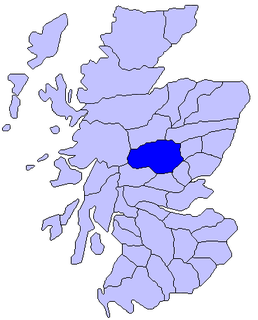
Atholl or Athole is a large historical division in the Scottish Highlands, bordering Marr, Badenoch, Lochaber, Breadalbane, Strathearn, Perth, and Gowrie. Historically it was a Pictish kingdom, becoming one of the original provinces of the Kingdom of Alba before being incorporated into the sheriffdom and later county of Perthshire. Today it forms the northern part of Perth and Kinross, Scotland.

Pitlochry is a town in the county of Perthshire in Scotland, lying on the River Tummel. It is administered as part of the council area of Perth and Kinross, and has a population of 2,776, according to the 2011 census.

Blair Atholl is a village in Perthshire, Scotland, built about the confluence of the Rivers Tilt and Garry in one of the few areas of flat land in the midst of the Grampian Mountains. The Gaelic place-name Blair, from blàr, 'field, plain', refers to this location. Atholl, which means 'new Ireland', from the archaic Ath Fhodla is the name of the surrounding district.

The Atholl Highlanders is a Scottish ceremonial infantry regiment. They are the only remaining private army in Europe, and act as the personal bodyguard to the Duke of Atholl, chieftain of the Clan Murray, a family that has thrived in Perthshire for some 750 years. Although it has no official military role, this hand-picked body of local men are armed with Lee–Metford rifles, and the regiment includes a pipe band. Joining the Highlanders is by invitation-only from the Duke, who specially selects men with ties to the estate or the local area. The regiment is not part of the British Army but under the command of the Duke of Atholl, and based at Blair Castle, Blair Atholl.

Blair Castle stands in its grounds near the village of Blair Atholl in Perthshire in Scotland. It is the ancestral home of the Clan Murray, and was historically the seat of their chief, the Duke of Atholl, though the current (12th) Duke, Bruce Murray, lives in South Africa. The castle stands in Glen Garry, and commands a strategic position on the main route through the central Scottish Highlands.

George Iain Murray, 10th Duke of Atholl, DL, known as Wee Iain, was a Scottish peer and landowner.
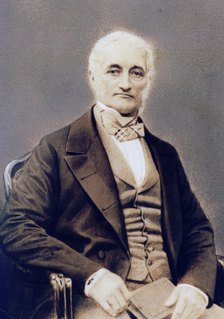
William Burn was a Scottish architect. He received major commissions from the age of 20 until his death at 81. He built in many styles and was a pioneer of the Scottish Baronial Revival.

Dunkeld is a town in Perth and Kinross, Scotland. The location of a historic cathedral, it lies on the north bank of the River Tay, opposite Birnam. Dunkeld lies close to the geological Highland Boundary Fault, and is frequently described as the "Gateway to the Highlands" due to its position on the main road and rail lines north. Dunkeld has a railway station, Dunkeld & Birnam, on the Highland Main Line, and is about 25 kilometres north of Perth on what is now the A9 road. The main road formerly ran through the town, however following modernisation of this road it now passes to the west of Dunkeld.

Clan Murray is a Highland Scottish clan. The chief of the Clan Murray holds the title of Duke of Atholl. Their ancestors who established the family in Scotland in the 12th century were the Morays of Bothwell. In the 16th century descendants of the Morays of Bothwell, the Murrays of Tullibardine, secured the chiefship of the clan and were created Earls of Tullibardine in 1606. The first Earl of Tullibardine married the heiress to the Stewart earldom of Atholl and Atholl therefore became a Murray earldom in 1626. The Murray Earl of Atholl was created Marquess of Atholl in 1676 and in 1703 it became a dukedom. The marquess of Tullibardine title has continued as a subsidiary title, being bestowed on elder sons of the chief until they succeed him as Duke of Atholl.

Blairquhan is a Regency era castle near Maybole in South Ayrshire, Scotland. It was the historic home of the Hunter-Blair Baronets and remained in the family's possession until 2012, when it was sold to a Chinese company.
A marriage stone, nuptial stone or lintel stone is usually a stone, rarely wood, lintel carved with the initials, coat of arms, etc. of a newly married couple, usually displaying the date of the marriage. They were very popular until Victorian times, but fell out of general use in the 20th century. Many survive for aesthetic value, particularly where well carved or of historic value. Many are part of or in the grounds of a listed building or in conservation areas.
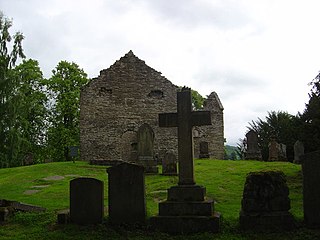
Old Blair is a tiny village of 18th century stone houses in Perth and Kinross, Scotland, adjoining and overlooking the grounds of Blair Castle. It is the site of St Bride's Kirk, the original church of Blair Atholl parish. This probably early Christian foundation was replaced by a new building in Blair Atholl village in the 19th century. There are substantial remains of the unroofed original church, set within an unwalled graveyard, though its western tower has been removed. The ancient building is flanked on the south side by a 'laird's aisle' of 16th century date, which encloses several monuments of the family of the Dukes of Atholl. John Graham of Claverhouse, 'Bonnie Dundee' is also buried in the vault below the aisle.

Ross Priory is an early 19th-century country house located west of Gartocharn, West Dunbartonshire, on the south shore of Loch Lomond, Scotland. From the 14th century the estate, known as The Ross, was owned by a branch of the Buchanan family of Buchanan Castle, who built a house here in 1695. The present house is the result of remodelling by James Gillespie Graham and was complete in 1816. The term "priory" does not imply ecclesiastical provenance, but is simply a 19th-century romantic affectation. Sir Walter Scott spent time at Ross Priory in the years following the rebuilding. It was owned by subsequent members of the Leith-Buchanan family until the later 20th century. In 1973 it was sold to Strathclyde University and now serves as a recreational and conference centre.

Stanley is a village on the north side of the River Tay in Perthshire, Scotland, around 6 miles north of Perth.

Caversfield is a village and civil parish about 1+1⁄2 miles (2.4 km) north of the centre of Bicester. In 1844 Caversfield became part of Oxfordshire, but until then it was always an exclave of Buckinghamshire. The 2011 Census recorded the parish's population as 1,788.
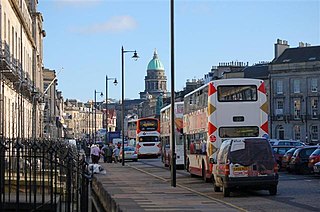
The West End of New Town - also known as Edinburgh's West End or West End Village - is an affluent district of Edinburgh, Scotland, which along with the rest of New Town, and also the Old Town forms central Edinburgh, and Edinburgh's UNESCO World Heritage Site. The area boasts several of the city's hotels, restaurants, independent shops, offices and arts venues, including the Edinburgh Filmhouse, Edinburgh International Conference Centre and the Caledonian Hotel. The area also hosts art festivals and crafts fairs.
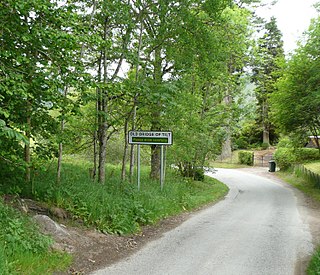
Bridge of Tilt is a village in Perthshire, Scotland, built around the River Tilt, near its confluence with the River Garry. It is 5+3⁄4 miles northwest of Pitlochry. The newer part of the village is continuous with Blair Atholl, only separated by the River Tilt. The village is located primarily on the B8079 between Pitlochry and Dunalastair Water, but the older part of the village is located further up the River Tilt. The A9 runs past the River Garry to the south of Bridge of Tilt, and connects the village with Newtonmore and Inverness in the north and Pitlochry, Perth and Stirling in the south.

Killiechassie is a country estate and house near Weem, about 1 mile northeast of Aberfeldy, in Perth and Kinross, Scotland. The estate lies on the banks of the River Tay in some 12 acres, about 74 miles north of Edinburgh. It was owned by the Douglas family in the latter part of the 19th century, and a new house was erected in 1865. A dovecote by the house was listed as Grade B on 9 June 1981. The house was purchased by author J.K. Rowling in 2001.

Richard and Robert Dickson were brothers, acting as architects in Scotland in the early and mid-19th century. Whilst most of their work is typified by remote country houses they are best known for their magnificent spire on the Tron Kirk in the heart of Edinburgh on the Royal Mile.



















